1990 VOLVO 240 ESP
[x] Cancel search: ESPPage 3 of 143

Volvo 1990 240 Model
compartment. For further information regarding these regulations, please\
contact your dealer. pg. 3 Seat belts: "Something We Believe In"
Despite our strongest recommendations, and your best intentions, not wea\
ring a seat belt is like
believing "It'll never happen to me!". Volvo urges you and all adult occ\
upants of your car to wear seat
belts and ensure that children are properly restrained, using an infant,\
car or booster seat determined by
age, weight and height.
Fact: Inevery state and province, some type of child-restraint legislati\
on has been passed. Additionally,
most states and provinces have already made it mandatory for occupants o\
f a car to use seat belts.
So, urging you to "buckle up" is not just our recommendation - legislati\
on in your state or province may
mandate seat belt usage. The few seconds it takes to buckle up may one d\
ay allow you to say, "It's a
good thing I was wearing my seat belt". pg. 4 General Information
Do not export your Volvo to another country before investigating the cou\
ntry's applicable safety and
exhaust emission requirements. In some cases it may be difficult or impo\
ssible to comply with these
requirements. Modifications to the emission control system(s) may rend\
er your Volvo not certifiable for
legal operation in the U.S., Canada or other countries.
Model versions of the basic Volvo Models 240, 240 DL
USA: Canada:
240 4-door, Wagon 240 DL 4-door, Wagon
240 DL 4-door, Wagon pg. 5 Keys
Owner's Key
This key operates all locks in the vehicle
Service Key
Front doors
Starting (ignition)/steering wheel lock
The key number codes are stamped on a separate tag supplied with the key\
s. This tag should be
file:///K|/ownersdocs/1990/1990_240/90240_00.htm (3 of 4)12/30/2006 8:\
25:01 AM
Page 13 of 143

Volvo 1990 240 Model
The gauge pointer must not go down to the red
field while driving.
Do not continue to drive the car with the pointer in
the red zone.
Note: While idling with a hot engine the pointer
may go into the red field. This is not a cause for
concern providing the pointer rises to the normal
driving range again when you increase the engine
speed. should be within the black field.
Should the pointer point to the upper or lower red
field when driving, this may indicate some fault in
the electrical system.
Note: While idling with a hot engine (especially
with air conditioning ON), the pointer may
indicate low voltage. This is not a cause for
concern provided that the indicated voltage
increases when you increase engine speed.
Contents | Top of Page
file:///K|/ownersdocs/1990/1990_240/90240_02.htm (4 of 4)12/30/2006 8:\
25:02 AM
Page 25 of 143
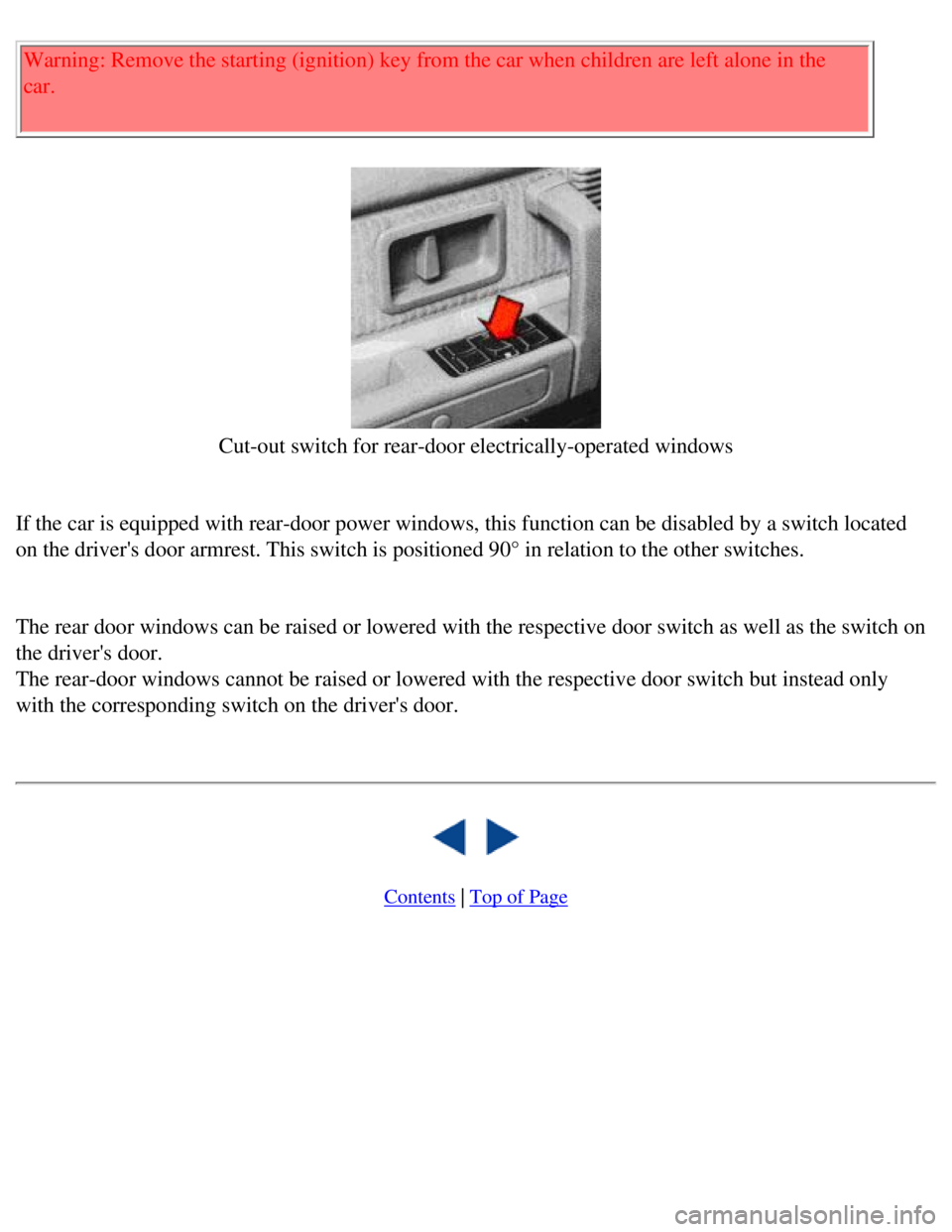
Volvo 1990 240 Model
Warning: Remove the starting (ignition) key from the car when children\
are left alone in the
car.
Cut-out switch for rear-door electrically-operated windows
If the car is equipped with rear-door power windows, this function can b\
e disabled by a switch located
on the driver's door armrest. This switch is positioned 90° in relati\
on to the other switches.
The rear door windows can be raised or lowered with the respective door \
switch as well as the switch on
the driver's door.
The rear-door windows cannot be raised or lowered with the respective do\
or switch but instead only
with the corresponding switch on the driver's door.
Contents | Top of Page
file:///K|/ownersdocs/1990/1990_240/90240_04.htm (5 of 5)12/30/2006 8:\
25:02 AM
Page 65 of 143
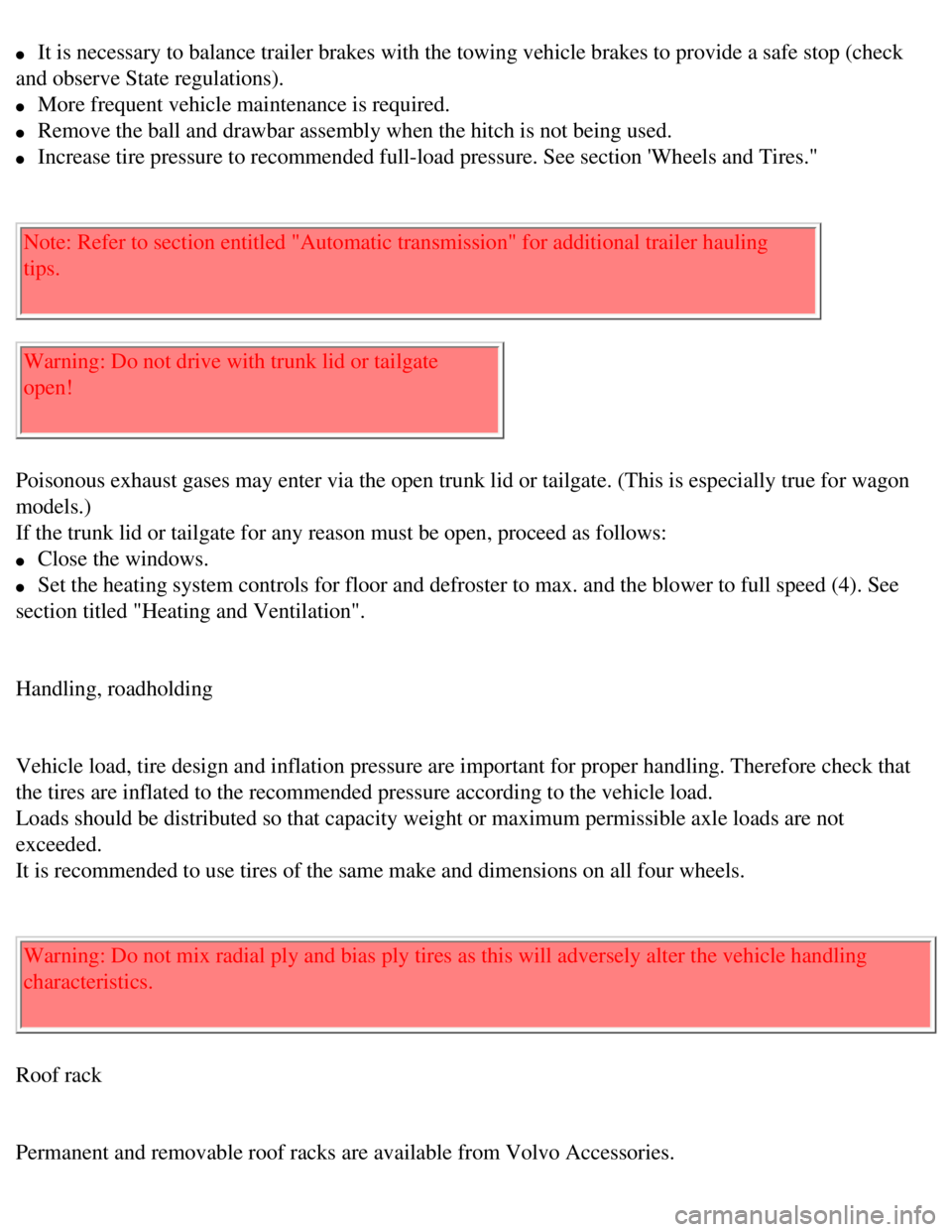
Volvo 1990 240 Model
l It is necessary to balance trailer brakes with the towing vehicle brakes\
to provide a safe stop (check
and observe State regulations).
l More frequent vehicle maintenance is required.
l Remove the ball and drawbar assembly when the hitch is not being used.
l Increase tire pressure to recommended full-load pressure. See section 'W\
heels and Tires."
Note: Refer to section entitled "Automatic transmission" for additional \
trailer hauling
tips.
Warning: Do not drive with trunk lid or tailgate
open!
Poisonous exhaust gases may enter via the open trunk lid or tailgate. (\
This is especially true for wagon
models.)
If the trunk lid or tailgate for any reason must be open, proceed as fol\
lows:
l Close the windows.
l Set the heating system controls for floor and defroster to max. and the \
blower to full speed (4). See
section titled "Heating and Ventilation".
Handling, roadholding
Vehicle load, tire design and inflation pressure are important for prope\
r handling. Therefore check that
the tires are inflated to the recommended pressure according to the vehi\
cle load.
Loads should be distributed so that capacity weight or maximum permissib\
le axle loads are not
exceeded.
It is recommended to use tires of the same make and dimensions on all fo\
ur wheels.
Warning: Do not mix radial ply and bias ply tires as this will adversely\
alter the vehicle handling
characteristics.
Roof rack
Permanent and removable roof racks are available from Volvo Accessories.\
file:///K|/ownersdocs/1990/1990_240/90240_11.htm (2 of 6)12/30/2006 8:\
25:06 AM
Page 66 of 143
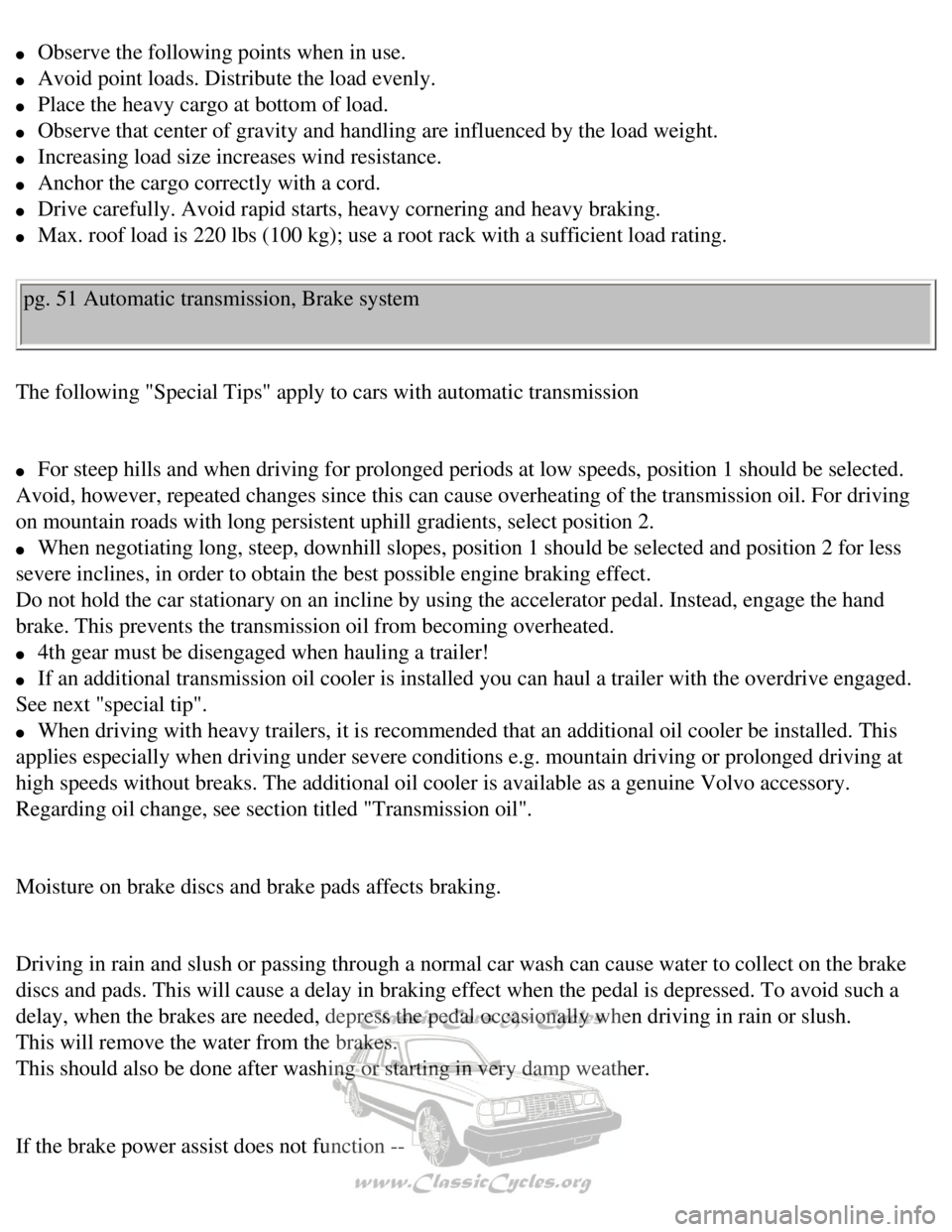
Volvo 1990 240 Model
l Observe the following points when in use.
l Avoid point loads. Distribute the load evenly.
l Place the heavy cargo at bottom of load.
l Observe that center of gravity and handling are influenced by the load w\
eight.
l Increasing load size increases wind resistance.
l Anchor the cargo correctly with a cord.
l Drive carefully. Avoid rapid starts, heavy cornering and heavy braking. \
l Max. roof load is 220 lbs (100 kg); use a root rack with a sufficient \
load rating.
pg. 51 Automatic transmission, Brake system
The following "Special Tips" apply to cars with automatic transmission
l For steep hills and when driving for prolonged periods at low speeds, po\
sition 1 should be selected.
Avoid, however, repeated changes since this can cause overheating of the\
transmission oil. For driving
on mountain roads with long persistent uphill gradients, select position\
2.
l When negotiating long, steep, downhill slopes, position 1 should be sele\
cted and position 2 for less
severe inclines, in order to obtain the best possible engine braking eff\
ect.
Do not hold the car stationary on an incline by using the accelerator pe\
dal. Instead, engage the hand
brake. This prevents the transmission oil from becoming overheated.
l 4th gear must be disengaged when hauling a trailer!
l If an additional transmission oil cooler is installed you can haul a tra\
iler with the overdrive engaged.
See next "special tip".
l When driving with heavy trailers, it is recommended that an additional o\
il cooler be installed. This
applies especially when driving under severe conditions e.g. mountain dr\
iving or prolonged driving at
high speeds without breaks. The additional oil cooler is available as a \
genuine Volvo accessory.
Regarding oil change, see section titled "Transmission oil".
Moisture on brake discs and brake pads affects braking.
Driving in rain and slush or passing through a normal car wash can cause\
water to collect on the brake
discs and pads. This will cause a delay in braking effect when the pedal\
is depressed. To avoid such a
delay, when the brakes are needed, depress the pedal occasionally when d\
riving in rain or slush.
This will remove the water from the brakes.
This should also be done after washing or starting in very damp weather.\
If the brake power assist does not function --
file:///K|/ownersdocs/1990/1990_240/90240_11.htm (3 of 6)12/30/2006 8:\
25:06 AM
Page 95 of 143
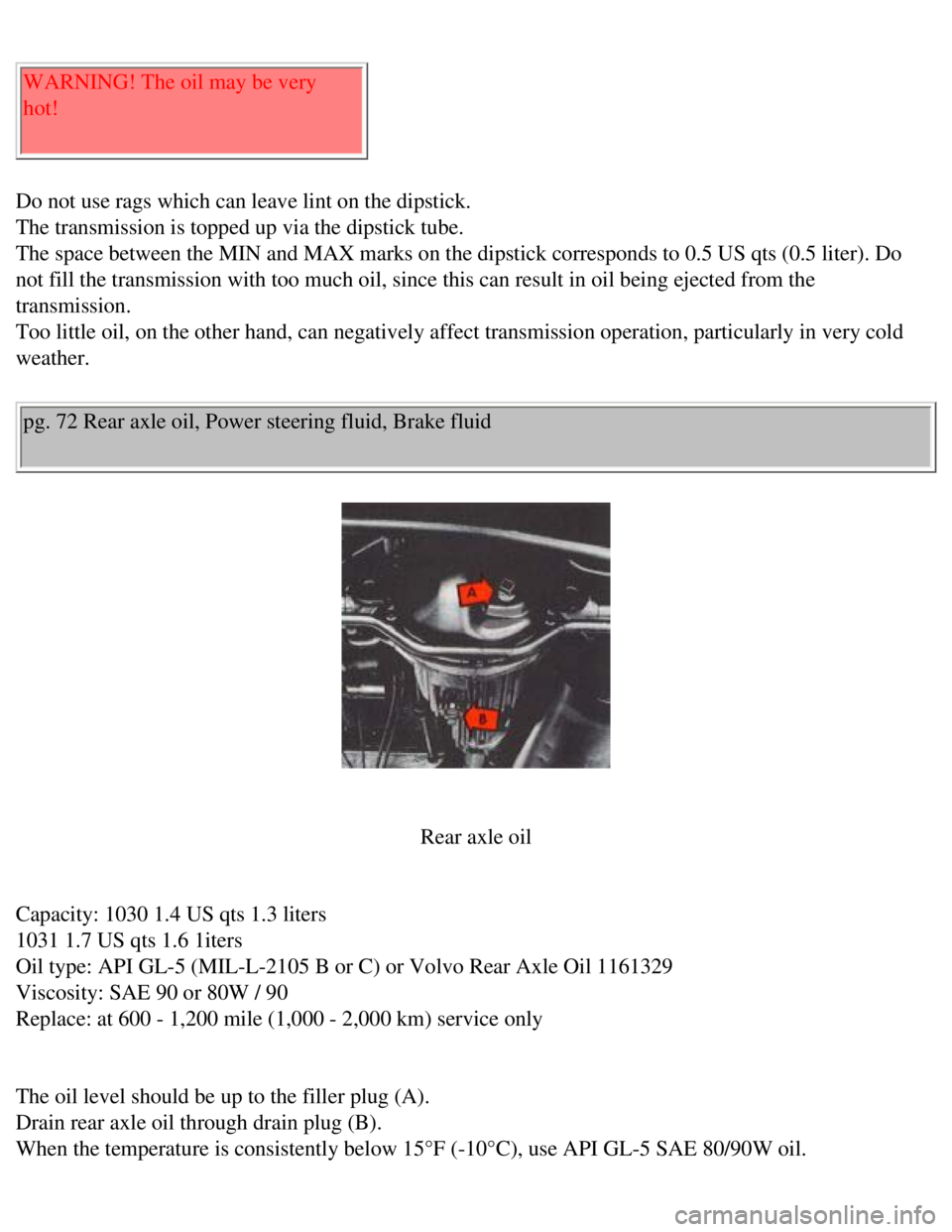
Volvo 1990 240 Model
WARNING! The oil may be very
hot!
Do not use rags which can leave lint on the dipstick.
The transmission is topped up via the dipstick tube.
The space between the MIN and MAX marks on the dipstick corresponds to 0\
.5 US qts (0.5 liter). Do
not fill the transmission with too much oil, since this can result in oi\
l being ejected from the
transmission.
Too little oil, on the other hand, can negatively affect transmission op\
eration, particularly in very cold
weather.
pg. 72 Rear axle oil, Power steering fluid, Brake fluid
Rear axle oil
Capacity: 1030 1.4 US qts 1.3 liters
1031 1.7 US qts 1.6 1iters
Oil type: API GL-5 (MIL-L-2105 B or C) or Volvo Rear Axle Oil 1161329 \
Viscosity: SAE 90 or 80W / 90
Replace: at 600 - 1,200 mile (1,000 - 2,000 km) service only
The oil level should be up to the filler plug (A).
Drain rear axle oil through drain plug (B).
When the temperature is consistently below 15°F (-10°C), use API\
GL-5 SAE 80/90W oil.
file:///K|/ownersdocs/1990/1990_240/90240_15.htm (3 of 10)12/30/2006 8\
:25:09 AM
Page 100 of 143
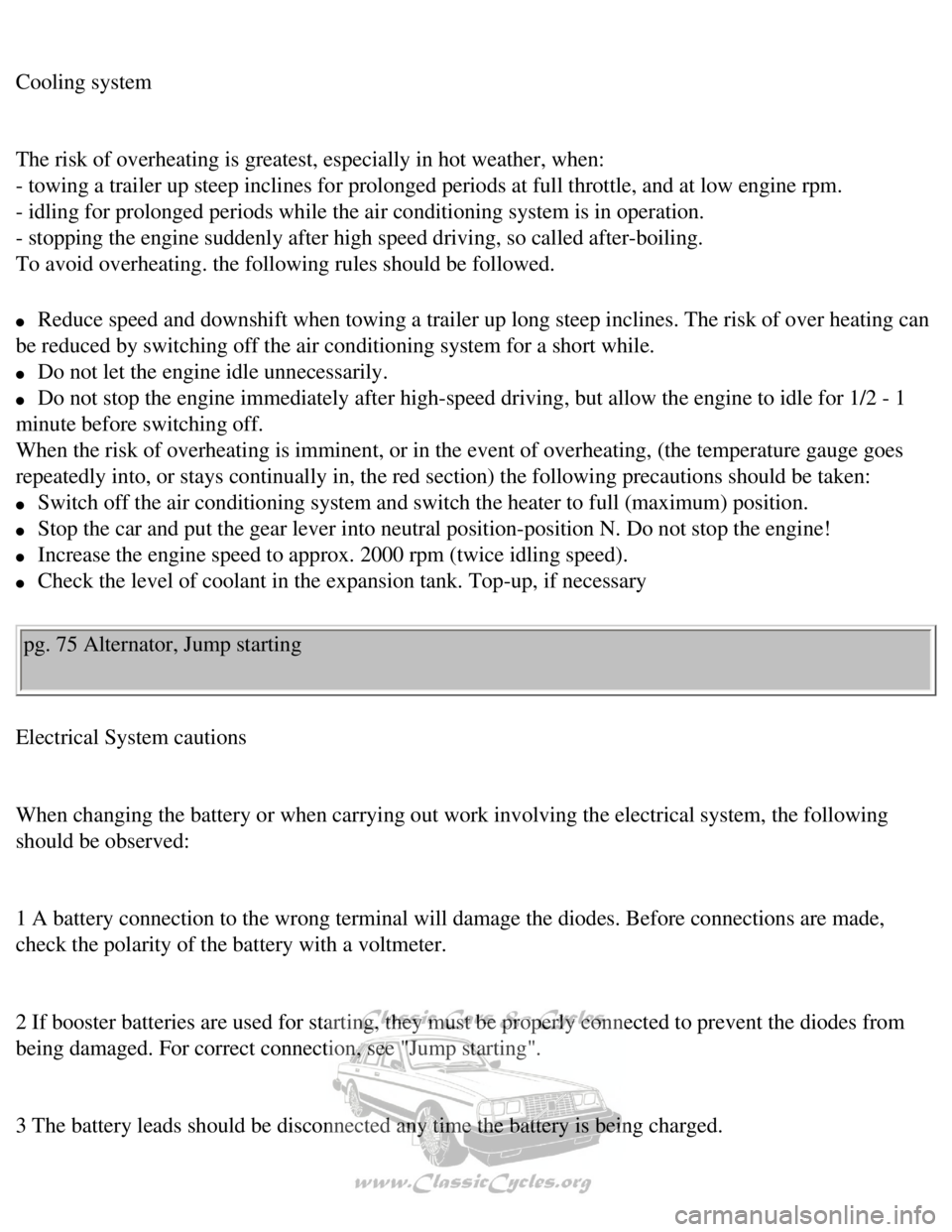
Volvo 1990 240 Model
Cooling system
The risk of overheating is greatest, especially in hot weather, when:
- towing a trailer up steep inclines for prolonged periods at full throt\
tle, and at low engine rpm.
- idling for prolonged periods while the air conditioning system is in o\
peration.
- stopping the engine suddenly after high speed driving, so called after\
-boiling.
To avoid overheating. the following rules should be followed.
l Reduce speed and downshift when towing a trailer up long steep inclines.\
The risk of over heating can
be reduced by switching off the air conditioning system for a short whil\
e.
l Do not let the engine idle unnecessarily.
l Do not stop the engine immediately after high-speed driving, but allow t\
he engine to idle for 1/2 - 1
minute before switching off.
When the risk of overheating is imminent, or in the event of overheating\
, (the temperature gauge goes
repeatedly into, or stays continually in, the red section) the followin\
g precautions should be taken:
l Switch off the air conditioning system and switch the heater to full (m\
aximum) position.
l Stop the car and put the gear lever into neutral position-position N. Do\
not stop the engine!
l Increase the engine speed to approx. 2000 rpm (twice idling speed).
l Check the level of coolant in the expansion tank. Top-up, if necessary
pg. 75 Alternator, Jump starting
Electrical System cautions
When changing the battery or when carrying out work involving the electr\
ical system, the following
should be observed:
1 A battery connection to the wrong terminal will damage the diodes. Bef\
ore connections are made,
check the polarity of the battery with a voltmeter.
2 If booster batteries are used for starting, they must be properly conn\
ected to prevent the diodes from
being damaged. For correct connection, see "Jump starting".
3 The battery leads should be disconnected any time the battery is being\
charged.
file:///K|/ownersdocs/1990/1990_240/90240_15.htm (8 of 10)12/30/2006 8\
:25:09 AM
Page 103 of 143

Volvo 1990 240 Model
pg. 76 Replacing bulbs
Replacing bulbs
The replacement of bulbs in the various lighting units is shown on the f\
ollowing pages. Make sure when
installing bulbs, that the guide pin on the socket fits into its corresp\
onding recess.
When installing bulbs, do not touch the glass with your fingers. The rea\
son for this is that grease, oil or
any other impurities can be carbonized onto the bulb and damage the refl\
ector.
Use bulbs of correct type and voltage. Failure to do so could activate t\
he bulb failure warning light.
Replacing headlight bulbs
Working inside the engine compartment, separate the socket contact from \
the bulb holder (1). Unscrew
and remove the bulb holder retaining ring (2) Pull out the bulb holder\
assembly, and replace it as a unit
(3).
Installation is the reverse of removal.
Check headlight alignment.
Bulb Power Trade No.
Headlamp 45/65W 9004
file:///K|/ownersdocs/1990/1990_240/90240_16.htm (1 of 10)12/30/2006 8\
:25:10 AM